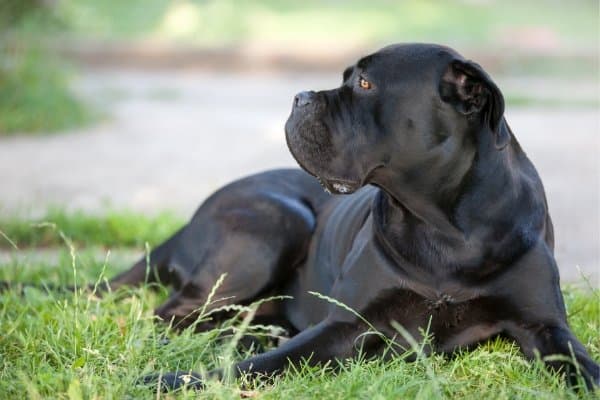The Cane Corso is an Italian working breed categorized as a Molosser, a group known for wide, deep chests; thick, heavily muscled bodies; and large build.
Breeds such as Neopolitan Mastiffs, Dogo Argentino, Boerboels, and Rottweilers are all considered to be Molosser-type dogs.
The most agile, energetic, and athletic of the Mastiff breeds, the Cane Corso is intimidating in appearance and fiercely protective of his home and family.
They were bred to be guard dogs, and today still excel in this role but also are often quite successful in competitions such as dock diving, agility, obedience trials, and rally events.
Can a Cane Corso live outside? In areas where temperatures are never too extreme, a Cane Corso can live outside, provided that his basic needs are met; he receives plenty of exercise, social interaction, and mental stimulation; and precautions are taken to ensure that he is comfortable and sheltered from the elements.
Let’s see what it takes to make it work and go over some inherent risks.
Can a Cane Corso Live Outside?
If given sufficient time to acclimate to the changing seasonal temperatures, a Cane Corso can adjust to outdoor life, growing a thick undercoat for the winter months and shedding the extra fur before the summer heat settles in.
Of course, basic needs such as access to fresh water, daily food, shelter, and protection from the wind must be met.
However, for a Cane Corso to thrive and remain happy and stable in temperament, he must also receive plenty of socialization (even as an adult), exercise, mental stimulation, and training reinforcement.
Simply relegating a Cane Corso to the backyard with little human interaction, no specific job to do, and no opportunity to enjoy life is one sure way to ruin a good dog.
Extra care must be given to ensure that this working breed still feels like part of the family and knows what his expected role is in that capacity, even if he must live outdoors.
Fun Fact: Black Cane Corsi almost always have an undercoat which is less dense than that of other colored Cane Corsi.
The reason is that the color black absorbs more heat from the sun, so black dogs don’t require as heavy an undercoat as others do.
Is The Outdoors Life Ideal?
While it is possible for a Cane Corso to live outside, and some even seem to enjoy it, having your Cane Corso live with you inside the house as part of the family unit is really best.
This is a breed that needs plenty of frequent human interaction, and like all dogs, they crave companionship. They form very strong bonds with their family and are devoted for life to those they love. While they do not constantly seek snuggles and affirmation as small lapdogs do, Cane Corsi do desire to be with their people.
Drawbacks to Housing Your Cane Corso Outside
Cane Corsi who are left alone outside for long portions of each day will not receive the mental stimulation that they need and may become destructive out of boredom. These dogs were bred to do a job, not sit in a backyard by themselves day after day.
A Cane Corso who is cut off from the family may grow unsociable or distrustful of people. With a dog as large and powerful as a Cane Corso, this is not what you want.
Lots of Cane Corso owners chose this breed because they were drawn to the protective, guarding nature for which Cane Corsi are famous. Does it make more sense to have your dog guarding only your backyard or to have him indoors with you, calmly watching over the entire household?
A quote I once read went something like this, “Pets are the family members we get to choose.” So true. It is a privilege to share your life with a dog. Don’t you want that dog and his unconditional love, friendship, and loyalty to truly be a part of your family? That’s hard to pull off if he lives outside.
How to Make It Work
If your Cane Corso must live outside, you’ll want to ensure that your dog is as comfortable as possible. A large, weather-resistant, insulated dog house is mandatory.
It should be large enough for your dog to be able to stand up and turn around easily without being so big that its heat-retaining properties are lost.
For your dog’s comfort, a waterproof dog bed could be placed inside the dog house. Some owners prefer to use a thick layer of straw for bedding, but it would need to be replaced periodically.
Towels and blankets should not be used in the dog house as they absorb moisture and can remain damp for long periods leaving your dog uncomfortable and perhaps even chilled.
Cold Weather Precautions
In very cold weather, a pet bed warmer may be necessary. Depending on the density of your dog’s undercoat, he may appreciate a weather-resistant winter jacket on bitterly cold days.
Access to a sun-drenched area will allow your Cane Corso to absorb some extra heat, especially if your dog is black.
Hot Weather Precautions
Cane Corsi, like other brachycephalic breeds, have a somewhat short muzzle relative to their body size which makes it more difficult for them to keep cool during the hot summer months.
An area with plenty of shade and access to a breeze is crucial for an outdoor Cane Corso. You’ll need to monitor him closely on super hot days to make sure that he doesn’t overheat.
A large pet pool filled with clean, cool water will give your dog a welcome reprieve from the heat. A cooling vest is another option to protect him from overheating.
Be Aware of Potential Dangers
While it is impossible to protect your dog from every conceivable danger, there are some common hazards associated with living outside that you should be aware of and protect your pet from.
- Poisonous plants.
- Spiteful neighbors.
- Large predators.
- Venomous snakes and insects.
- Toxic pesticides.
- Extreme weather conditions.
Can a Cane Corso Live in an Apartment?
Usually calm and quiet when indoors, Cane Corsi can adapt to apartment life, but there are a few aspects you should consider first before deciding if you really want to share your apartment with this breed.
Cane Corsi Are Big
There is nothing small about a Cane Corso. This powerful, muscular breed often weighs 120 pounds and reaches a shoulder height of between 24 – 28 inches tall. If your apartment is on the small side, things might get a little bit crowded when a Cane Corso is added to the mix.
They’ll Need Lots of Exercise
In addition to at least 20 minutes of training work, mental stimulation, or playtime each day, Cane Corsi will also need a brisk walk or jog of at least one mile two times per day to expend some of their energy and maintain peak fitness.
Bad behavior can result when a Cane Corso is not given enough physical activity, and in an apartment, this could be devastating. Taking a couple of weeks off from the exercise routine is not an option for these dogs. Be certain that you can commit to meeting all of his needs.
They Are Not the Most Friendly Breed
Although a Cane Corso does indeed develop a great affection for his family, this breed usually retains a natural wariness of others and may never form strong friendships with other people, not even neighbors he sees routinely.
If properly socialized and well trained, a Cane Corso should not be indiscriminately aggressive with a neighbor without good cause, but your neighbors may not appreciate his intimidating looks and stand-offish attitude. Your relationship with your neighbors may be negatively affected by this.
Final Thoughts
If circumstances dictate that you must keep your Cane Corso outside, that’s understandable, and know that as long as you continue to meet all of his needs, physically, mentally, and emotionally, it can work.
However, if you are considering getting a Cane Corso to merely have an imposing deterrent outside, then having an electronic security system installed may be a better option.





